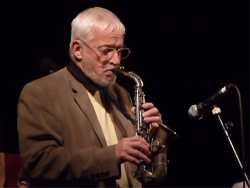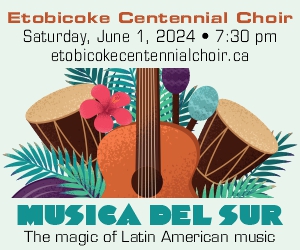 The Ken Page Memorial Trust will hold its 17th Annual Jazz Fundraiser on Thursday, October 22 at the Old Mill in Toronto. This autumn jazz bash has become a local institution and as ever, will be conducted along the lines of a jazz party, combining some of the best American mainstream jazz artists with a cadre of Toronto’s elite musicians in an informal, but musical, jam-session format. The lineup of prodigious talent promises a jazz banquet and plenty of interaction between players of like instruments. The trumpeters will be Warren Vaché, one of the most lyrically inventive cornetists in jazz, Guido Basso and his sophisticated and mellifluous flugelhorn artistry and John MacLeod, who favours the cornet and is equally well-versed in traditional and modern jazz styles.
The Ken Page Memorial Trust will hold its 17th Annual Jazz Fundraiser on Thursday, October 22 at the Old Mill in Toronto. This autumn jazz bash has become a local institution and as ever, will be conducted along the lines of a jazz party, combining some of the best American mainstream jazz artists with a cadre of Toronto’s elite musicians in an informal, but musical, jam-session format. The lineup of prodigious talent promises a jazz banquet and plenty of interaction between players of like instruments. The trumpeters will be Warren Vaché, one of the most lyrically inventive cornetists in jazz, Guido Basso and his sophisticated and mellifluous flugelhorn artistry and John MacLeod, who favours the cornet and is equally well-versed in traditional and modern jazz styles.
The trombone will be handled by the fine Chicago-based veteran Russ Phillips – whose father replaced Jack Teagarden with Louis Armstrong’s All-Stars in 1951 – and Toronto’s Alastair Kay, simply one of the best trombonists in the world, Canada’s answer to Urbie Green for 35 years now.
The evening will boast some great reed players: the hard-swinging tenor saxophonist Harry Allen; Ken Peplowski, best-known for his virtuosic clarinet but also a fine tenor player; the stylistically versatile Scott Robinson, who plays all the reeds but specializes in the rarely heard bass and contrabass saxophones; and Toronto’s John MacMurchy on tenor and clarinet, a fine player who deserves to be more widely known.
Brooklyn-born pianist Johnny Varro, now 85 and a much-revered veteran of swing and mainstream circles, will be the only American in an otherwise all-Toronto rhythm section. Multi-instrumentalist Don Thompson will play vibes (probably also some piano) and Reg Schwager – who can play anything – will be the guitarist. Providing the bedrock will be two of Canada’s very best – Neil Swainson on bass and Terry Clarke on drums.
As great as this cornucopia of jazz talent is, there will be something missing from this year’s bash – for the first time Jim Galloway will be absent, owing to his death this past December after several months of illness. Jim was a founding member of the KPMT and its musical director for the past 16 years, so dying was probably the only thing that could keep him away from such a jazz jamboree. It won’t be quite the same without him; he’ll be missed both musically and personally. This year’s event is billed as a tribute to Jim. There will no doubt be some stories told about him and some fond memories rekindled. He played with all the musicians involved often over the years so they’ll no doubt summon his spirit – he won’t be there in person, but he will be present nonetheless.
This is just the kind of jazz setting Jim relished – freewheeling, diverse and informal, with no written music. He loved the spontaneous give-and-take that can occur between musicians with nothing planned and no structure except a common heritage of standard tunes and knowledge of jazz tradition. He excelled at directing traffic in these groupings to avoid monotony – a trumpet-piano duet here, three saxophones a cappella there, perhaps just trombone and bass for a chorus. He understood that special music can be made when good musicians are playing their best but are relaxed and having fun, not being competitive but rather mutually inspiring.
In his heart of hearts he was a jazz musician but that label is insufficient, as he was much more: an important booking agent; an
organizer and hustler who created jazz policies in unexpected and unlikely locations; a broadcaster; a writer – including for this publication. From 1981 to 1987 he was the host and music director for the Saturday matinee broadcast Toronto Alive!, which involved many visiting American artists with local rhythm sections. This led to him being made artistic director of the newly launched Toronto Jazz Festival in 1987, a post he held until a few years ago.
As the primary local voice and champion of older jazz – trad and swing – Jim held a unique and significant place on the Toronto jazz scene. There seem to be more people interested in these earlier styles in larger cities with bigger jazz scenes. However, as his long record in booking the Jazz Festival showed, he was not narrow in his tastes. Mainstream jazz was simply the music he was interested in playing and the music he found his voice in. He loved Armstrong and Bechet, Ellington, stride piano, Fletcher Henderson, early Basie and other Kansas City jazz and had an encyclopedic knowledge of the details of jazz from before World War II – the records, repertoire and styles.
He was a well-read man of wide knowledge and many interests – I’m told his large personal library had books on an amazing range of subjects – music of course, cooking, wine, history, film (he was an expert on the films of Buster Keaton), all sorts of things. He was a connoisseur of single-malt Scotch whisky and enjoyed his drams. His motto was: “If you only drink the good stuff, it won’t hurt you.” The scent of his Balkan Sobranie clove cigarettes often announced his arrival in a club well before he was spotted. Despite these vices, he was quite healthy and a long-time vegetarian, one of many paradoxes about him.
Mostly self-taught, Jim was not a technician but an ear player, a feeling player, an instinctive musician. He had the important jazz virtues. He loved songs and swing, developed a very personal sound – especially on soprano saxophone – and had a desire and ability to communicate directly with his audience which was always sincere, never commercial. His sense of jazz integrity earned him an international reputation. He was well-known and highly regarded wherever he played – Europe (especially Britain, France and Switzerland) and the U.S., at many festivals, and on the jazz party circuit. He often said that if he sent someone home from a performance feeling better than when they came in, then he’d done his job well. He accomplished this often enough that he was welcome all over the world.
I’d like to close with a story about Jim that I heard shortly after his death, from his good friend Ted O’Reilly. Some of the more modern, post-bebop musicians in Toronto occasionally looked down on Jim as being old-hat because he loved 30s and 40s jazz so. I always found this troubling because it was intolerant and didn’t accord him the respect he deserved and there may have been some jealousy involved. Jim was probably aware of this, but was a humorous and affable man who generally liked to avoid hostility and conflict. He had a quick and ready wit though and could muster a sharp riposte when needed, as in the following: Once in the 90s, he was playing a gig that involved, among others, a dyed-in-the-wool bebop trumpet player, who shall remain nameless. At some point, he snarled at Jim, “Don’t you ever get tired of playing that old crap?” – or words to that effect – and Jim retorted, “No, I don’t, do you?” In other words, I love older jazz and you love bebop, but bebop is not exactly new either, so I’ll play mine and you play yours and let’s have a little mutual respect, all right?
It’s reminiscent of something Lester Young once said about individuality in an interview (and I’m quoting loosely): “Boom ... You play your licks and I’ll play my licks and it’s that way till death do us part.”
Toronto bassist Steve Wallace writes a blog called “Steve Wallace – jazz, baseball, life and other ephemera” which can be accessed at wallacebass.



